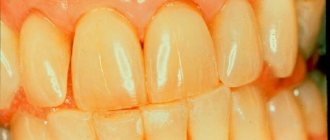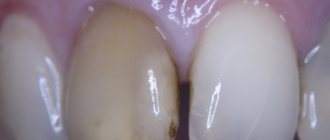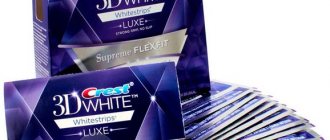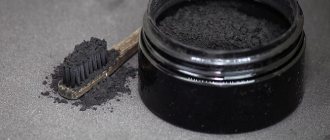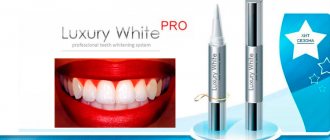In some diets, products are selected not by calorie content or composition, but by color. For example, in dentistry there is a so-called white diet after teeth whitening, in which restrictions apply specifically to the color of the foods and drinks consumed. It is necessary to consolidate the results of teeth whitening and maintain the achieved enamel color. This diet is also used for home whitening, and in this case, “colored” foods will have to be avoided during the entire period of whitening procedures and the first weeks after their completion.
What should be the diet after teeth whitening?
To record the result achieved after teeth whitening and prevent the appearance of unwanted marks from food dyes on the teeth, it is recommended to follow a special “white” (sometimes also called transparent) diet in the first 2-3 weeks after the procedure. Moreover, you only need to strictly adhere to this diet for the first three days; in the future, you can and should begin to gradually introduce familiar foods into the menu, for example, you can drink coffee or black tea, but only through a straw.
You should eat in your usual way; there are no restrictions on the number of meals or the amount of food itself. The most important limitation is the color of the products.
The culprits of the problem
Many foods and drinks contain natural or artificial coloring substances that, to one degree or another, change the shade of tooth enamel. To avoid darkening or yellowing of crowns, it is worth knowing their list.
Tea
Black tea contains a large amount of active substances - tannins. Penetrating into the pores of the enamel, they connect with the cells of the dental tissue, giving the teeth a yellowish tint.
To prevent the appearance of pigmented areas of the enamel after each tea drinking, it is necessary to brush your teeth or use a mouth rinse.
At the same time, tea has a pronounced bactericidal effect, thanks to which it protects the gums from the effects of microorganisms. Green and white teas are recognized as the safest and healthiest for enamel.
Coffee
Coffee contains heavy carbohydrates, cocoa butter and the same sugar in quantities dangerous to enamel. They are able to penetrate deep into the pores of dentin, leading to the formation of plaque and the appearance of yellowish-gray pigment spots on the enamel.
If you do not clean your teeth in a timely manner after drinking a coffee drink, such pigmented areas can eventually be removed only through in-office whitening.
In addition, drinking coffee contributes to a change in acidity in the mouth, leading to an increase in the number of bacteria and the formation of stones.
Fruit juices
Natural juices squeezed from dark fruits and berries are rich in phosphoric acid. Under its influence, the top layer of enamel is destroyed and numerous pores form in it.
Due to the penetration of natural pigment substances, which are rich in juices, into the resulting gaps, the teeth acquire a reddish, bluish or other tint, depending on the color of the berries used.
Juices from dark berries – blueberries, cherries, blueberries – have the greatest coloring effect. Most often, enamel that has changed color can be easily restored to whiteness with the help of toothpaste and mouthwash.
Detailed instructions for using Dental Drops and a review of analogues. Click here if you are interested in Amazing White oxygen teeth whitening.
At this address https://dr-zubov.ru/ortopediya/nesemnye-protezy/koronki/keramicheskaya-vybiraem-luchshee.html we suggest looking at photos of ceramic crowns for the front teeth.
Berries
Berries have a lesser effect on tooth enamel than juices. This happens because when they are consumed, saliva is released, which neutralizes the aggressive effects of coloring components. .
The consumption of currants, blackberries, blueberries, mulberries, cherries, and blueberries causes a temporary change in the color of the enamel. Bluish pigmentation can be easily removed using standard hygiene products.
However, it is worth remembering that frequent consumption of dark berries and untimely care of the crowns can lead to their yellowing.
Carbonated drinks
Carbonated drinks contain large amounts of sugar and various acids. These components have an aggressive effect on the enamel, thinning its top layer and opening the pores.
Artificial dyes present in such drinks penetrate through open pores into enamel prisms and settle in them. In addition to the darkening that occurs over time with regular consumption of soda, the enamel becomes susceptible to carious lesions.
Watch the video to see how carbonated drinks affect tooth enamel.
Chocolate
The effect of chocolate on the tooth surface depends on its type.
Milk chocolate contains a large amount of sugar, which gradually destroys tooth enamel, contributing to its staining under the influence of chromogens from various products.
In addition, milk chocolate and candies with glaze provoke the appearance of an unpleasant odor from the mouth.
Dark chocolate with at least 56% cocoa content has a positive effect on teeth.
Cocoa butter envelops the crowns with a protective film, protecting them from damage. In addition, the antiseptic properties of cocoa beans are known. They fight the formation of plaque and stone.
Learn more about when to start brushing your child's teeth and how to get him used to brushing his teeth every day. In this article, we suggest finding out how much it costs to insert a metal-ceramic tooth, the price of crowns and specialist services.
Follow the link https://dr-zubov.ru/krasota-i-uxod/sredstva/zubnye-niti/kak-pravilno-i-bezopasno-polzovatsya.html and watch a video on how to use dental floss.
Sauces and seasonings
Many dark-colored sauces, such as soy or balsamic vinegar, have a sour taste and contain acids that damage the integrity of the top layer of tooth enamel.
As a result, the chromogens contained in these products penetrate through the pores of dental tissue deep into the dentin surface and become fixed there.
Tomato paste and sauces prepared on its basis are also among the coloring products, after consuming which you need to brush your teeth or use a mouthwash.
Dentists recommend using dark sauces as little as possible and, if possible, replacing them with light analogues, for example, lemon juice or rice sauce.
Red wine
The burgundy hue of red wine and the abundance of tannins in it lead to significant staining of the surface of the crowns. In addition, the enamel's sensitivity to high and low temperatures increases.
White wine is no less harmful to the tooth surface. It contains acids that promote the formation of microcracks in the enamel, which facilitates the penetration of coloring pigments into the deeper layers of dentin.
Over time, teeth acquire a persistent grayish-yellow tint.
Beet
Beets have a rich burgundy color, which when consumed instantly colors the surface of the crowns. The vegetable contains a huge amount of chromogens. These organic pigments are able to penetrate even the smallest pores present on intact enamel.
Regular consumption of beets leads to deep penetration and stable fixation of chromogens on the dentin surface, which gives the crown a dirty yellow tint.
Eating dishes containing beets requires timely cleaning of the dentition or rinsing it with water or special preparations.
Spices
Some spices, such as curry and turmeric, which have a rich yellow color, can contribute to discoloration of crowns. The high concentration of color pigment in these products is not lost even during heat treatment.
Frequent consumption of foods containing these spices over time leads to yellowing of tooth enamel and even acquiring a reddish tint.
In order to timely neutralize color pigments, it is recommended that after each meal containing turmeric, rinse the mouth with water and lemon juice.
Turnip
Turnips are vegetables whose heat treatment enhances the release of coloring elements and their penetration into the pores of the tooth surface. Therefore, dishes with boiled or baked turnips contribute to the coloration of the tooth surface in a pale yellow tint.
The effect of color change from taking this product is short-term; after cleaning the crowns with a toothbrush and toothpaste, they acquire a natural white color.
Candy with food coloring
Numerous sweets, such as caramel, chewing gum, and marmalade, contain a large number of synthetic dyes.
The use of such products leads to a short-term change in the color of the tongue and enamel.
However, if you often eat sweets, the artificial pigments and sugar present in their composition will gradually destroy the enamel and penetrate deeper into the pores of the tooth. Over time, the tooth surface will become grayish in color.
To avoid this, after each use of sweets, you need to brush your teeth with a toothbrush and toothpaste and rinse your mouth with special products.
“White” diet after teeth whitening: what can you eat?
It is highly desirable that the menu includes products that benefit dental tissues, and not just those that are safe for enamel in terms of staining. The diet should contain a lot of calcium and fluoride-containing foods; they will help strengthen the enamel and prevent its increased sensitivity, which may appear during the first time after whitening procedures. It is recommended to include in your daily menu:
- Dairy products that do not contain dyes and fruit fillers: cottage cheese, milk, yogurt, butter.
- Sea fish and other seafood. Moreover, when buying cut fish, you should make sure that it is not tinted with food coloring (dyed fish leaves distinct pink marks on the packaging or plate).
- Pears, bananas, pineapple - any fruit that does not contain a large amount of fruit acids and cannot stain the enamel.
- Asparagus, celery, cauliflower.
- Chicken or turkey meat.
- Rice, potatoes, champignons and porcini mushrooms.
- Bread and bakery products made from wholemeal white flour.
- Egg whites. Yolks are excluded from the diet because they also stain the enamel.
This “food set” will allow you to eat well, get all the substances your body needs, and at the same time will not harm your enamel.
What causes the color to change
Discoloration of enamel occurs as a result of thinning of its top layer, which leads to exposure of pores. This situation contributes to the unhindered penetration of chromogens into them - organic pigments contained in products.
Often the cause of enlarged pores is the use of products containing acids, which help loosen the enamel.
Thinning enamel occurs in people of all ages. In adults, changes in dental tissue can be age-related; in young people, they can be caused by frequent consumption of acid-containing drinks or foods.
What can't you eat on a white diet?
Here is a list of foods that you will have to decisively and completely give up during the “white” diet:
- Coffee and tea, including green. Although many people believe that green tea is non-staining and safe, it still leaves a very noticeable residue on their surfaces.
- “Colored” vegetables, berries and fruits.
- Sweets with cocoa, chocolates, caramels, lollipops, dragees, etc.
- Coloring drinks: red wine, carbonated drinks with coloring, fruit and vegetable juices and fruit drinks.
- Sauces with coloring substances - soy and tomato, adjika, etc.
Write a comment
Nina
August 2, 2021 at 3:33 am
Teeth whitening is the most problematic part of my oral care. My teeth have a yellowish tint. All the dentists told me that whitening would be very difficult. But I decided to try anyway. At first I whitened with toothpaste. It did not help. Then I started going to dental clinics. There was an effect. But after some time the teeth darkened. Only later did I learn about the existence of the “white” diet. Now I stick to it, but I now have to treat my teeth at the dentist much more often.
Irina
August 2, 2021 at 10:22 pm
I suffered for a long time with the yellowness of my teeth until I removed the stones, but my teeth did not become pure white, after the procedure they became lighter by about a tone, but after cleaning, other methods of teeth whitening began to help, although previously they had not worked at all. I’m thinking about professional teeth whitening, but it will be difficult for me to follow a diet; I have no willpower at all!
Julia
August 12, 2021 at 9:23 am
I suffer from unhealthy teeth color mainly due to smoking and a special love for coffee in unlimited quantities. What have I not tried! I whitened both at dentists and at home using folk remedies. All this, of course, helps for a while, but the effect does not last long. I’m tired of fighting this, I have no strength! I read about the white diet, but in my opinion it is too cruel.
Victoria
November 4, 2021 at 5:03 pm
I’ve never heard of the white diet, but by the way, it’s very logical. For example, if we want our laundry to remain white, we will not wash it with colored items. Same with white teeth. I try to brush my teeth immediately after eating, but it turns out that after some coloring foods it’s better not to brush your teeth right away, I’ll take note. I also rinse with baking soda, it whitens teeth very well and has an anti-inflammatory effect.
Vasilisa
June 24, 2021 at 02:27 pm
If you look at it from the perspective of the average person, the “white diet” is quite complex. And if you can try to exclude sweets, turnips, beets and even sauces, then it is quite difficult to exclude the same fruits/berries and drinks. I'm not even talking about the fact that such a desire must be present.


